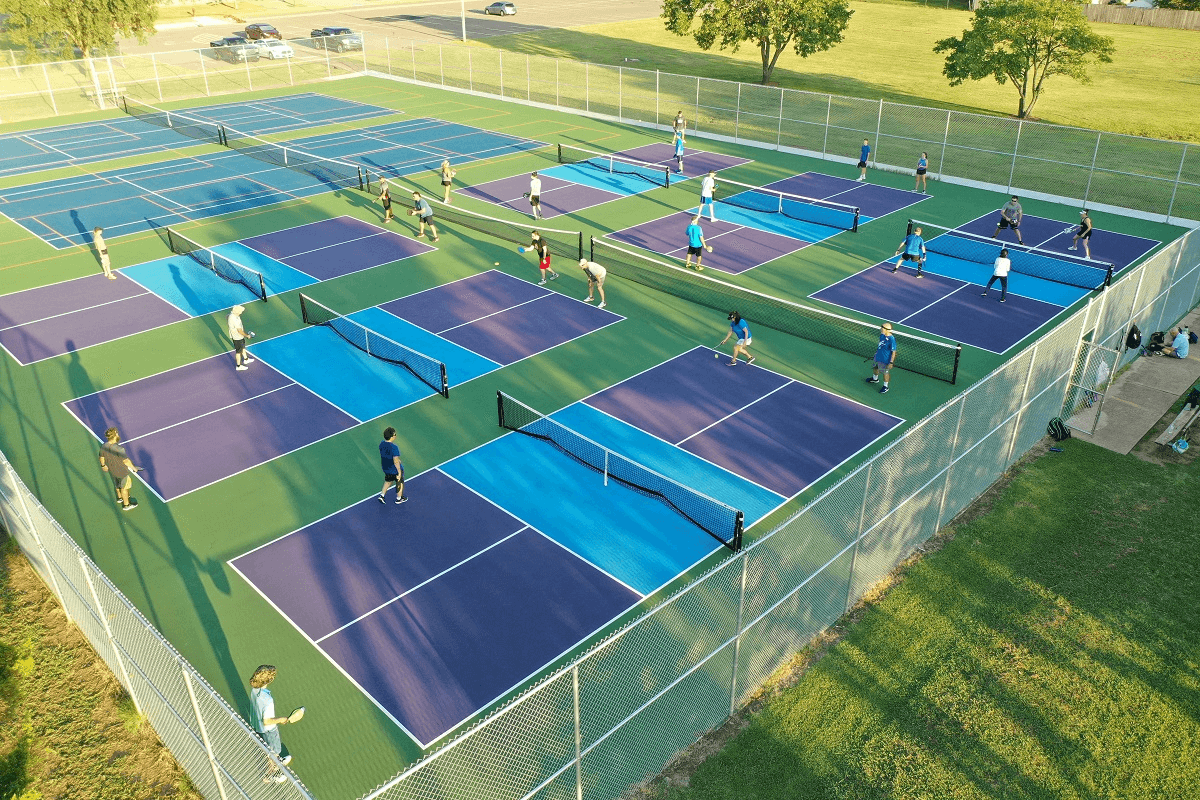Why Illinois and Midwest Are Choosing United States for Pickleball Courts Layout & Building
Why Illinois and Midwest Are Choosing United States for Pickleball Courts Layout & Building
Blog Article
Trick Consider the Construction of Pickleball Courts: From Website Selection to Last Finishes
The construction of pickleball courts encompasses a variety of critical factors, starting with the choice of an appropriate website that stabilizes access with ecological considerations. Vital aspects such as court measurements, surface area materials, and water drainage systems substantially influence not only the top quality of play but likewise the longevity of the facility. In addition, attention to lights and finishing touches can elevate the overall experience for gamers and viewers alike. Understanding exactly how each of these parts interrelates might reveal insights that are usually overlooked, triggering a more detailed exam of best methods in court building and construction.
Site Selection Requirements
When starting the building and construction of pickleball courts, it is important to nail down the site choice requirements that will guarantee ideal playability and availability. The place needs to be quickly obtainable for players, ideally located near houses or recreation center, to encourage participation.
Moreover, the terrain must be degree and secure, as unequal ground can bring about safety and security dangers and influence gameplay. Ample water drainage is additionally important; picking a website with great water overflow will help maintain court conditions throughout negative climate.
An additional essential consideration is the accessibility of utilities. Access to electrical power and water is needed for illumination and upkeep objectives. Additionally, distance to auto parking facilities is essential, helping with very easy accessibility for gamers and viewers alike.
Ecological elements can not be overlooked; all-natural color from trees can enhance player convenience, while exposure to prevailing winds may interfere with play. Zoning laws and community assistance should be taken into consideration to ensure that the job straightens with local standards and obtains the backing it requires for effective implementation. By meticulously evaluating these requirements, stakeholders can develop an inviting and practical setting for pickleball enthusiasts.
Court Dimensions and Format
To ensure optimal gameplay and adherence to policies, the dimensions and design of pickleball courts should be very carefully specified. A common pickleball court gauges 20 feet in size and 44 feet in size for both songs and increases play.
The web elevation is evaluated 36 inches at the sidelines and 34 inches at the facility, producing a minor dip that influences round trajectory. Court markings are just as crucial; lines must be 2 inches large and unique in color to guarantee visibility.
Additionally, a buffer area bordering the court is a good idea, normally prolonging 5 to 10 feet past the sidelines and baselines to accommodate players' activities and boost security. Appropriate layout and dimensions not just make sure compliance with official laws yet likewise improve the general playing experience, accommodating both entertainment and affordable play. Cautious planning in these locations is vital to the effective construction of pickleball courts.
Surface Material Options
Picking the appropriate surface area product for pickleball courts is critical for ensuring optimal gamer efficiency and safety. The choice of surface area can substantially affect gameplay, consisting of sphere bounce, grip, and gamer comfort.
There are a number of alternatives readily available, each with its unique characteristics. Asphalt is a prominent selection as a result of its toughness and reduced upkeep requirements. It link gives a solid having fun surface that can stand up to various climate conditions however might require routine resurfacing.
Concrete is another commonly made use of material, using excellent durability and a smooth coating. It permits constant round bounce but can be tough on gamers' joints, making it less preferable for lasting play without proper cushioning.
For those looking for boosted comfort and shock absorption, cushioned acrylic surface areas offer a practical choice. These surface areas combine a base layer with an acrylic topcoat, providing enhanced traction and a softer feeling, which is beneficial for decreasing the danger of injuries.
Lastly, synthetic grass is obtaining grip, particularly for multi-purpose facilities. Its adaptability and reduced upkeep requires make it an appealing choice, though it might not give the very same ball reaction as standard tough courts. Mindful factor to consider of these look these up options will ensure an optimal playing environment.
Water Drainage and Lighting Considerations
Appropriate drainage and effective lights are crucial elements in the building of pickleball courts, significantly affecting both playability and security. Adequate water drainage systems stop water accumulation, which can lead to unsafe surfaces and damages to the court framework.
Lighting is equally important, specifically for courts planned for evening use. The placement of illumination components must be purposefully intended to eliminate shadows and provide even distribution of light across the court.

Final Coatings and Upkeep
After attending to water drainage and lights considerations, attention turns to the last surfaces and continuous maintenance of pickleball courts. Usual alternatives include acrylic finishings and specialized sporting activities surfaces that provide my latest blog post optimal traction and padding.

Seasonal upkeep might include resurfacing every couple of years, depending on use and environmental elements. Effectively maintaining webs, court lines, and surrounding locations is equally essential to give a safe and satisfying having fun experience. By investing in top quality coatings and adhering to a structured maintenance timetable, facility owners can ensure their pickleball courts continue to be in excellent condition for many years ahead.
Conclusion
In final thought, the successful building and construction of pickleball courts rests on precise interest to numerous vital factors. Site choice must focus on accessibility and terrain security, while court measurements and format must abide by optimal requirements for gameplay. The option of surface area product dramatically affects gamer safety and security and performance. Moreover, reliable water drainage and sufficient lighting add to court longevity and visibility. High quality surfaces and a robust upkeep timetable are necessary for protecting the court's condition, boosting the general experience for players and spectators alike.
Report this page